A Report on Monitoring and Evaluation in Healthcare: US Organizations
VerifiedAdded on 2021/06/17
|6
|1383
|35
Report
AI Summary
This report provides an overview of monitoring and evaluation processes in the healthcare sector, with a focus on the United States. It details the roles and responsibilities of key organizations involved in ensuring healthcare quality, including the Joint Commission, the United States Food and Drug Administration (FDA), and the Accreditation Commission for Health Care (ACHC). The report describes the accreditation cycles, duties, and methods employed by each organization, such as surveys, standard updates, and patient involvement. The report emphasizes the importance of these processes in improving patient safety, regulating health services, and assuring consumers of the quality of care. It also highlights how monitoring and evaluation have influenced healthcare policies and service delivery in the US, leading to the adoption of best practices and consumer confidence.
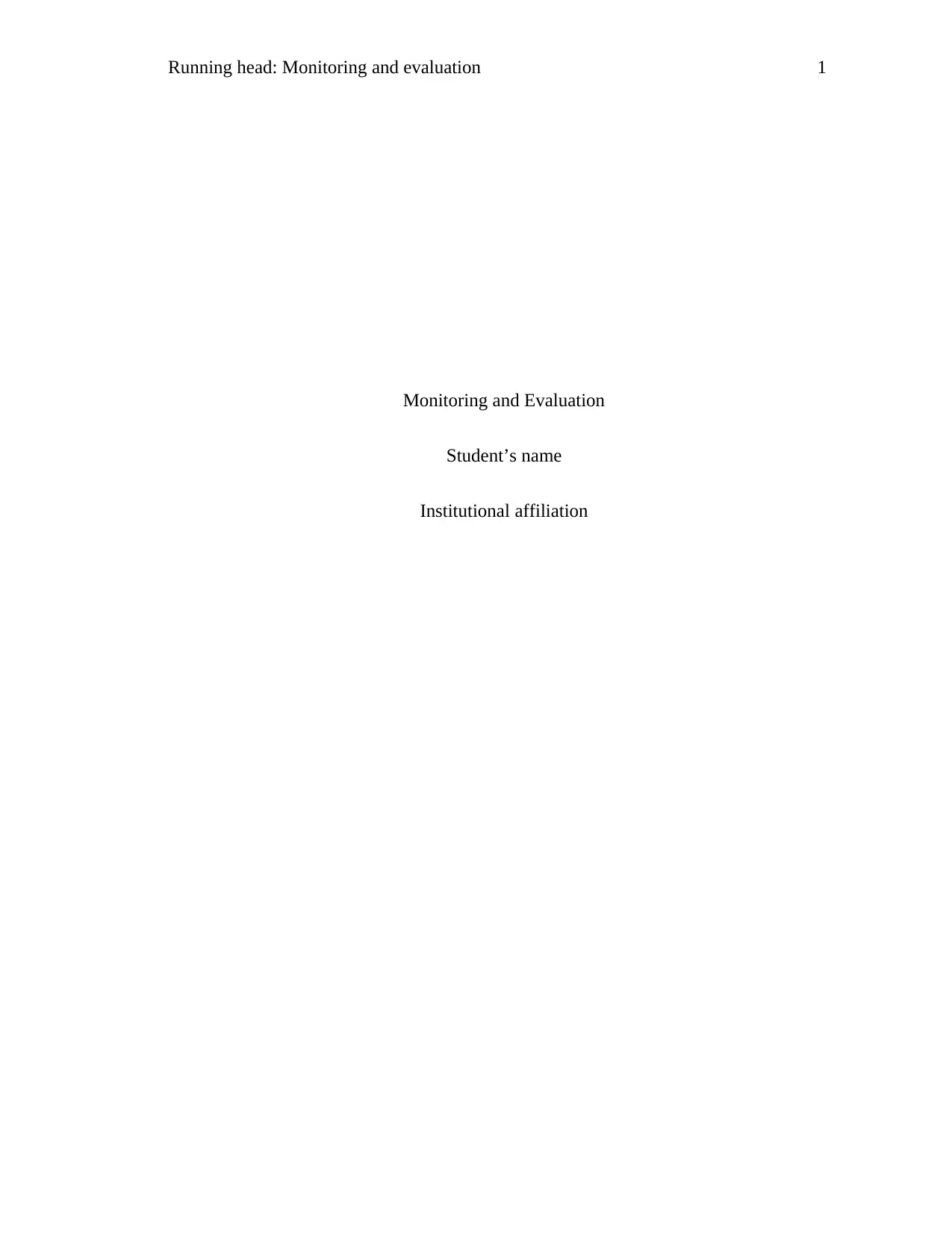
Running head: Monitoring and evaluation 1
Monitoring and Evaluation
Student’s name
Institutional affiliation
Monitoring and Evaluation
Student’s name
Institutional affiliation
Paraphrase This Document
Need a fresh take? Get an instant paraphrase of this document with our AI Paraphraser
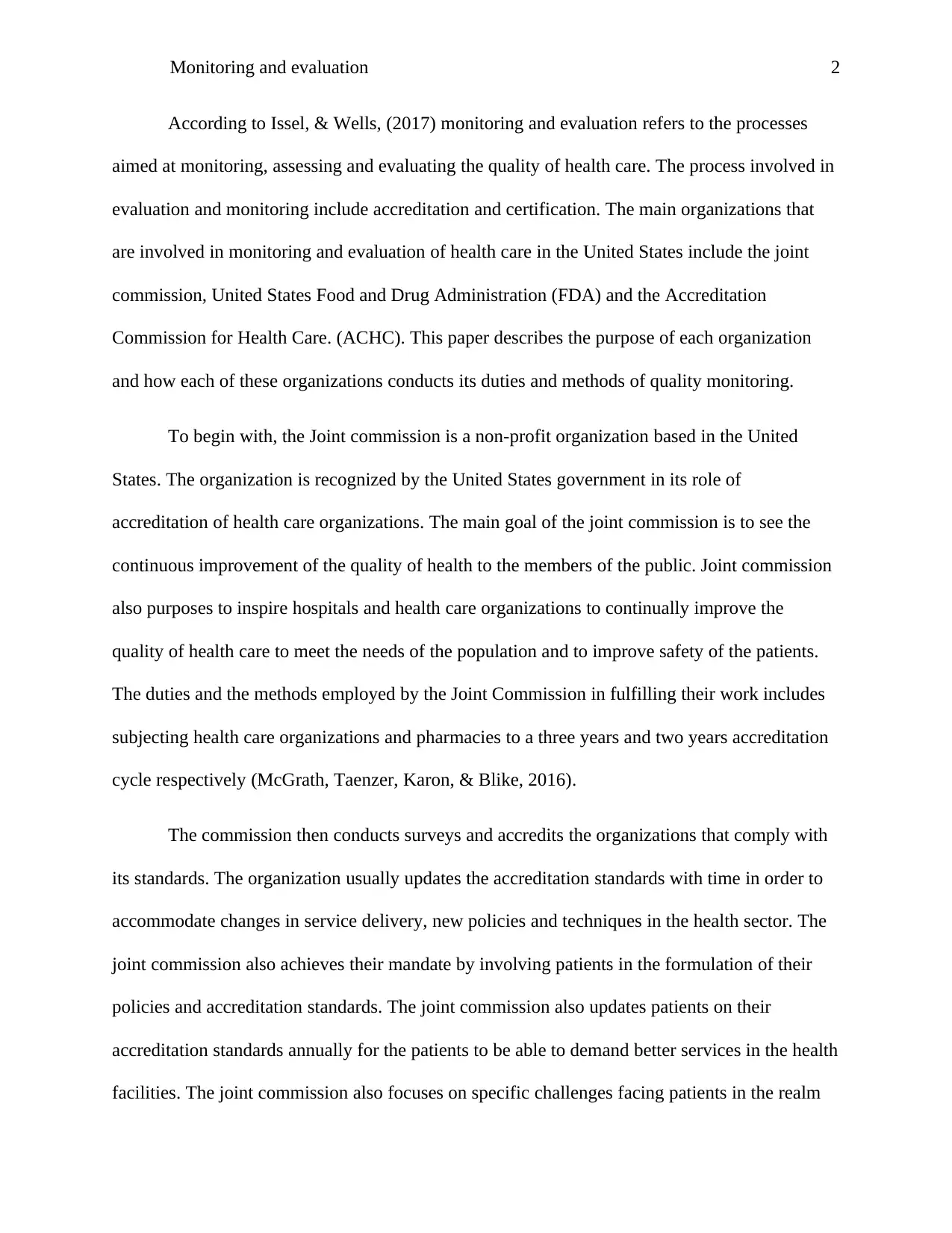
Monitoring and evaluation 2
According to Issel, & Wells, (2017) monitoring and evaluation refers to the processes
aimed at monitoring, assessing and evaluating the quality of health care. The process involved in
evaluation and monitoring include accreditation and certification. The main organizations that
are involved in monitoring and evaluation of health care in the United States include the joint
commission, United States Food and Drug Administration (FDA) and the Accreditation
Commission for Health Care. (ACHC). This paper describes the purpose of each organization
and how each of these organizations conducts its duties and methods of quality monitoring.
To begin with, the Joint commission is a non-profit organization based in the United
States. The organization is recognized by the United States government in its role of
accreditation of health care organizations. The main goal of the joint commission is to see the
continuous improvement of the quality of health to the members of the public. Joint commission
also purposes to inspire hospitals and health care organizations to continually improve the
quality of health care to meet the needs of the population and to improve safety of the patients.
The duties and the methods employed by the Joint Commission in fulfilling their work includes
subjecting health care organizations and pharmacies to a three years and two years accreditation
cycle respectively (McGrath, Taenzer, Karon, & Blike, 2016).
The commission then conducts surveys and accredits the organizations that comply with
its standards. The organization usually updates the accreditation standards with time in order to
accommodate changes in service delivery, new policies and techniques in the health sector. The
joint commission also achieves their mandate by involving patients in the formulation of their
policies and accreditation standards. The joint commission also updates patients on their
accreditation standards annually for the patients to be able to demand better services in the health
facilities. The joint commission also focuses on specific challenges facing patients in the realm
According to Issel, & Wells, (2017) monitoring and evaluation refers to the processes
aimed at monitoring, assessing and evaluating the quality of health care. The process involved in
evaluation and monitoring include accreditation and certification. The main organizations that
are involved in monitoring and evaluation of health care in the United States include the joint
commission, United States Food and Drug Administration (FDA) and the Accreditation
Commission for Health Care. (ACHC). This paper describes the purpose of each organization
and how each of these organizations conducts its duties and methods of quality monitoring.
To begin with, the Joint commission is a non-profit organization based in the United
States. The organization is recognized by the United States government in its role of
accreditation of health care organizations. The main goal of the joint commission is to see the
continuous improvement of the quality of health to the members of the public. Joint commission
also purposes to inspire hospitals and health care organizations to continually improve the
quality of health care to meet the needs of the population and to improve safety of the patients.
The duties and the methods employed by the Joint Commission in fulfilling their work includes
subjecting health care organizations and pharmacies to a three years and two years accreditation
cycle respectively (McGrath, Taenzer, Karon, & Blike, 2016).
The commission then conducts surveys and accredits the organizations that comply with
its standards. The organization usually updates the accreditation standards with time in order to
accommodate changes in service delivery, new policies and techniques in the health sector. The
joint commission also achieves their mandate by involving patients in the formulation of their
policies and accreditation standards. The joint commission also updates patients on their
accreditation standards annually for the patients to be able to demand better services in the health
facilities. The joint commission also focuses on specific challenges facing patients in the realm
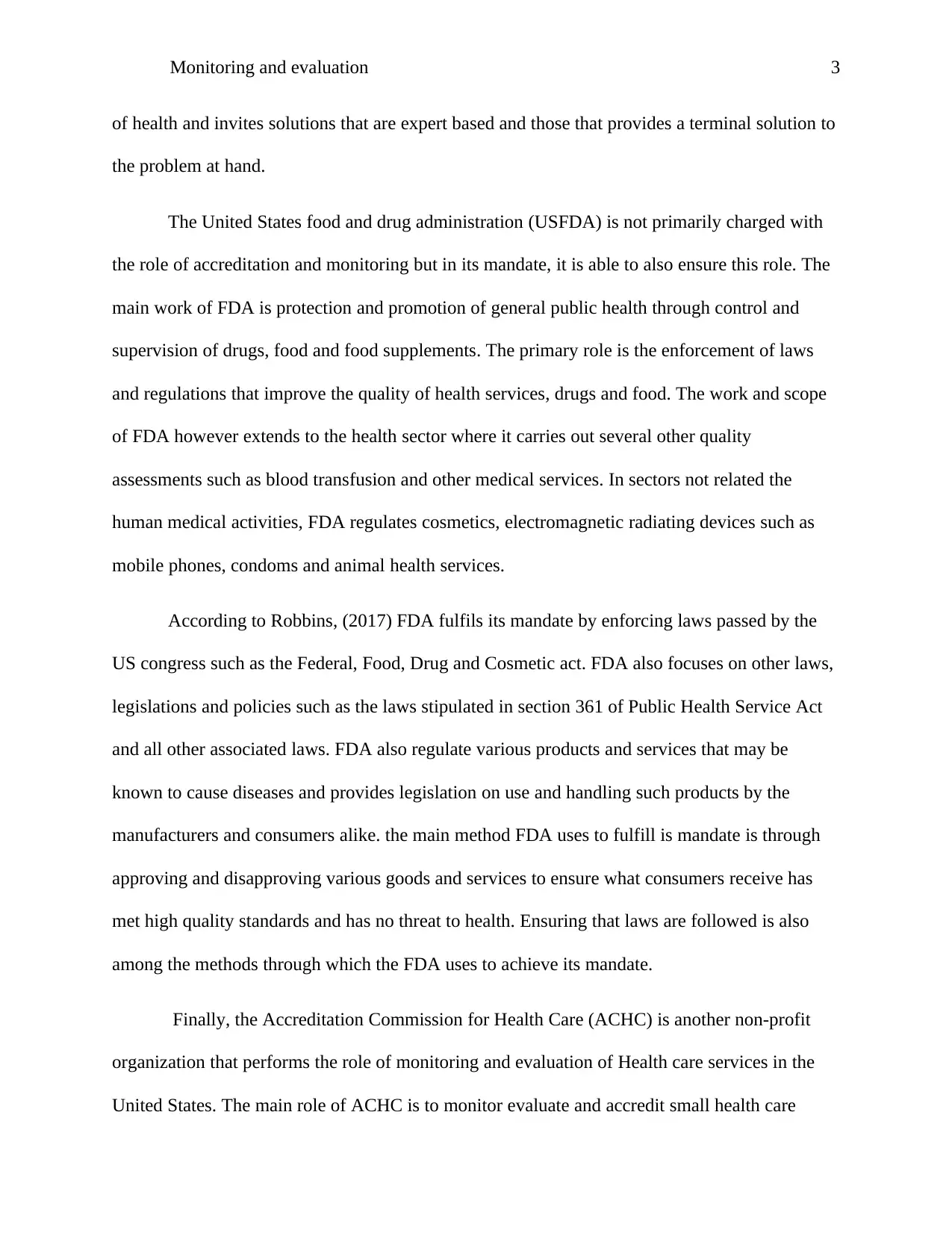
Monitoring and evaluation 3
of health and invites solutions that are expert based and those that provides a terminal solution to
the problem at hand.
The United States food and drug administration (USFDA) is not primarily charged with
the role of accreditation and monitoring but in its mandate, it is able to also ensure this role. The
main work of FDA is protection and promotion of general public health through control and
supervision of drugs, food and food supplements. The primary role is the enforcement of laws
and regulations that improve the quality of health services, drugs and food. The work and scope
of FDA however extends to the health sector where it carries out several other quality
assessments such as blood transfusion and other medical services. In sectors not related the
human medical activities, FDA regulates cosmetics, electromagnetic radiating devices such as
mobile phones, condoms and animal health services.
According to Robbins, (2017) FDA fulfils its mandate by enforcing laws passed by the
US congress such as the Federal, Food, Drug and Cosmetic act. FDA also focuses on other laws,
legislations and policies such as the laws stipulated in section 361 of Public Health Service Act
and all other associated laws. FDA also regulate various products and services that may be
known to cause diseases and provides legislation on use and handling such products by the
manufacturers and consumers alike. the main method FDA uses to fulfill is mandate is through
approving and disapproving various goods and services to ensure what consumers receive has
met high quality standards and has no threat to health. Ensuring that laws are followed is also
among the methods through which the FDA uses to achieve its mandate.
Finally, the Accreditation Commission for Health Care (ACHC) is another non-profit
organization that performs the role of monitoring and evaluation of Health care services in the
United States. The main role of ACHC is to monitor evaluate and accredit small health care
of health and invites solutions that are expert based and those that provides a terminal solution to
the problem at hand.
The United States food and drug administration (USFDA) is not primarily charged with
the role of accreditation and monitoring but in its mandate, it is able to also ensure this role. The
main work of FDA is protection and promotion of general public health through control and
supervision of drugs, food and food supplements. The primary role is the enforcement of laws
and regulations that improve the quality of health services, drugs and food. The work and scope
of FDA however extends to the health sector where it carries out several other quality
assessments such as blood transfusion and other medical services. In sectors not related the
human medical activities, FDA regulates cosmetics, electromagnetic radiating devices such as
mobile phones, condoms and animal health services.
According to Robbins, (2017) FDA fulfils its mandate by enforcing laws passed by the
US congress such as the Federal, Food, Drug and Cosmetic act. FDA also focuses on other laws,
legislations and policies such as the laws stipulated in section 361 of Public Health Service Act
and all other associated laws. FDA also regulate various products and services that may be
known to cause diseases and provides legislation on use and handling such products by the
manufacturers and consumers alike. the main method FDA uses to fulfill is mandate is through
approving and disapproving various goods and services to ensure what consumers receive has
met high quality standards and has no threat to health. Ensuring that laws are followed is also
among the methods through which the FDA uses to achieve its mandate.
Finally, the Accreditation Commission for Health Care (ACHC) is another non-profit
organization that performs the role of monitoring and evaluation of Health care services in the
United States. The main role of ACHC is to monitor evaluate and accredit small health care
⊘ This is a preview!⊘
Do you want full access?
Subscribe today to unlock all pages.

Trusted by 1+ million students worldwide
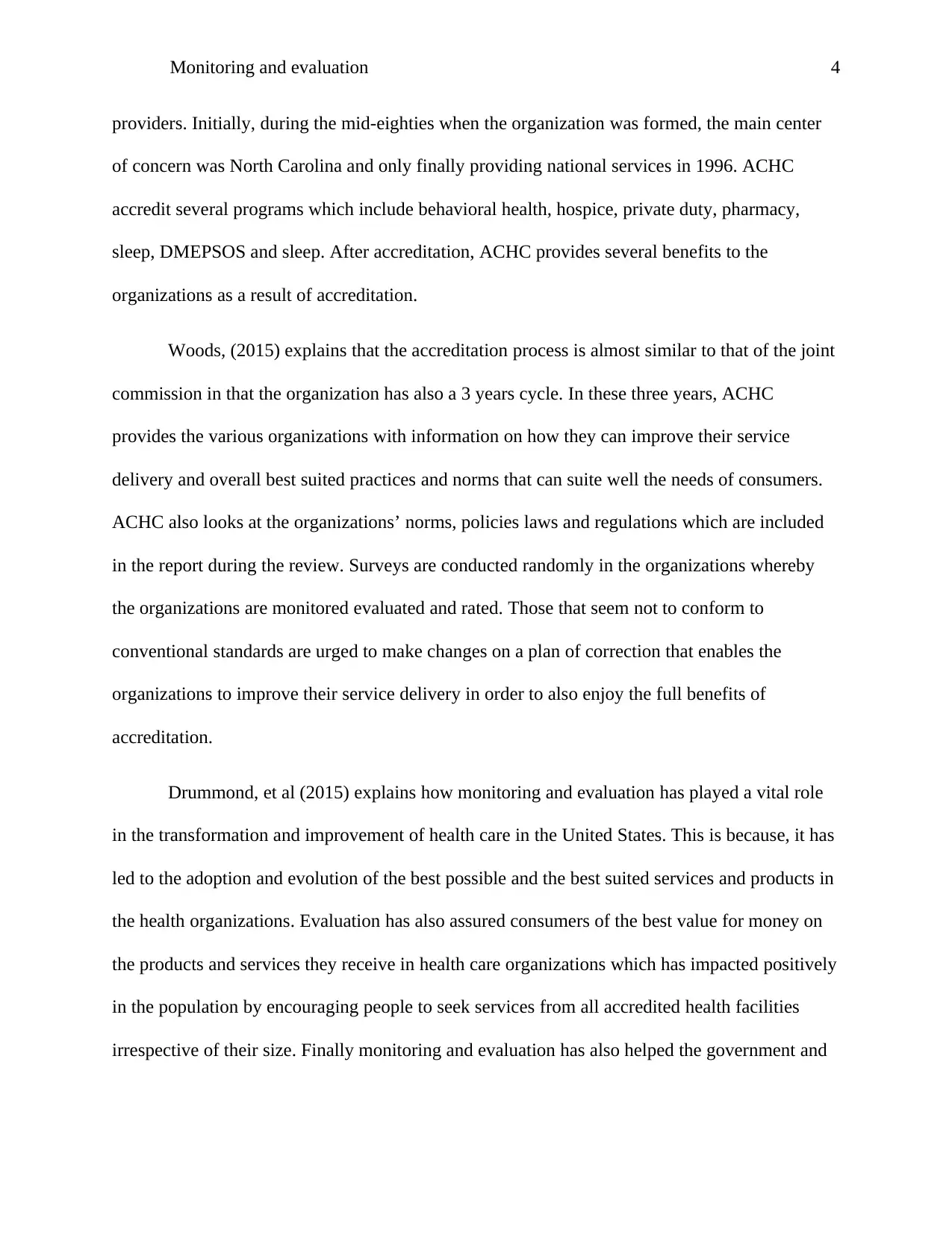
Monitoring and evaluation 4
providers. Initially, during the mid-eighties when the organization was formed, the main center
of concern was North Carolina and only finally providing national services in 1996. ACHC
accredit several programs which include behavioral health, hospice, private duty, pharmacy,
sleep, DMEPSOS and sleep. After accreditation, ACHC provides several benefits to the
organizations as a result of accreditation.
Woods, (2015) explains that the accreditation process is almost similar to that of the joint
commission in that the organization has also a 3 years cycle. In these three years, ACHC
provides the various organizations with information on how they can improve their service
delivery and overall best suited practices and norms that can suite well the needs of consumers.
ACHC also looks at the organizations’ norms, policies laws and regulations which are included
in the report during the review. Surveys are conducted randomly in the organizations whereby
the organizations are monitored evaluated and rated. Those that seem not to conform to
conventional standards are urged to make changes on a plan of correction that enables the
organizations to improve their service delivery in order to also enjoy the full benefits of
accreditation.
Drummond, et al (2015) explains how monitoring and evaluation has played a vital role
in the transformation and improvement of health care in the United States. This is because, it has
led to the adoption and evolution of the best possible and the best suited services and products in
the health organizations. Evaluation has also assured consumers of the best value for money on
the products and services they receive in health care organizations which has impacted positively
in the population by encouraging people to seek services from all accredited health facilities
irrespective of their size. Finally monitoring and evaluation has also helped the government and
providers. Initially, during the mid-eighties when the organization was formed, the main center
of concern was North Carolina and only finally providing national services in 1996. ACHC
accredit several programs which include behavioral health, hospice, private duty, pharmacy,
sleep, DMEPSOS and sleep. After accreditation, ACHC provides several benefits to the
organizations as a result of accreditation.
Woods, (2015) explains that the accreditation process is almost similar to that of the joint
commission in that the organization has also a 3 years cycle. In these three years, ACHC
provides the various organizations with information on how they can improve their service
delivery and overall best suited practices and norms that can suite well the needs of consumers.
ACHC also looks at the organizations’ norms, policies laws and regulations which are included
in the report during the review. Surveys are conducted randomly in the organizations whereby
the organizations are monitored evaluated and rated. Those that seem not to conform to
conventional standards are urged to make changes on a plan of correction that enables the
organizations to improve their service delivery in order to also enjoy the full benefits of
accreditation.
Drummond, et al (2015) explains how monitoring and evaluation has played a vital role
in the transformation and improvement of health care in the United States. This is because, it has
led to the adoption and evolution of the best possible and the best suited services and products in
the health organizations. Evaluation has also assured consumers of the best value for money on
the products and services they receive in health care organizations which has impacted positively
in the population by encouraging people to seek services from all accredited health facilities
irrespective of their size. Finally monitoring and evaluation has also helped the government and
Paraphrase This Document
Need a fresh take? Get an instant paraphrase of this document with our AI Paraphraser
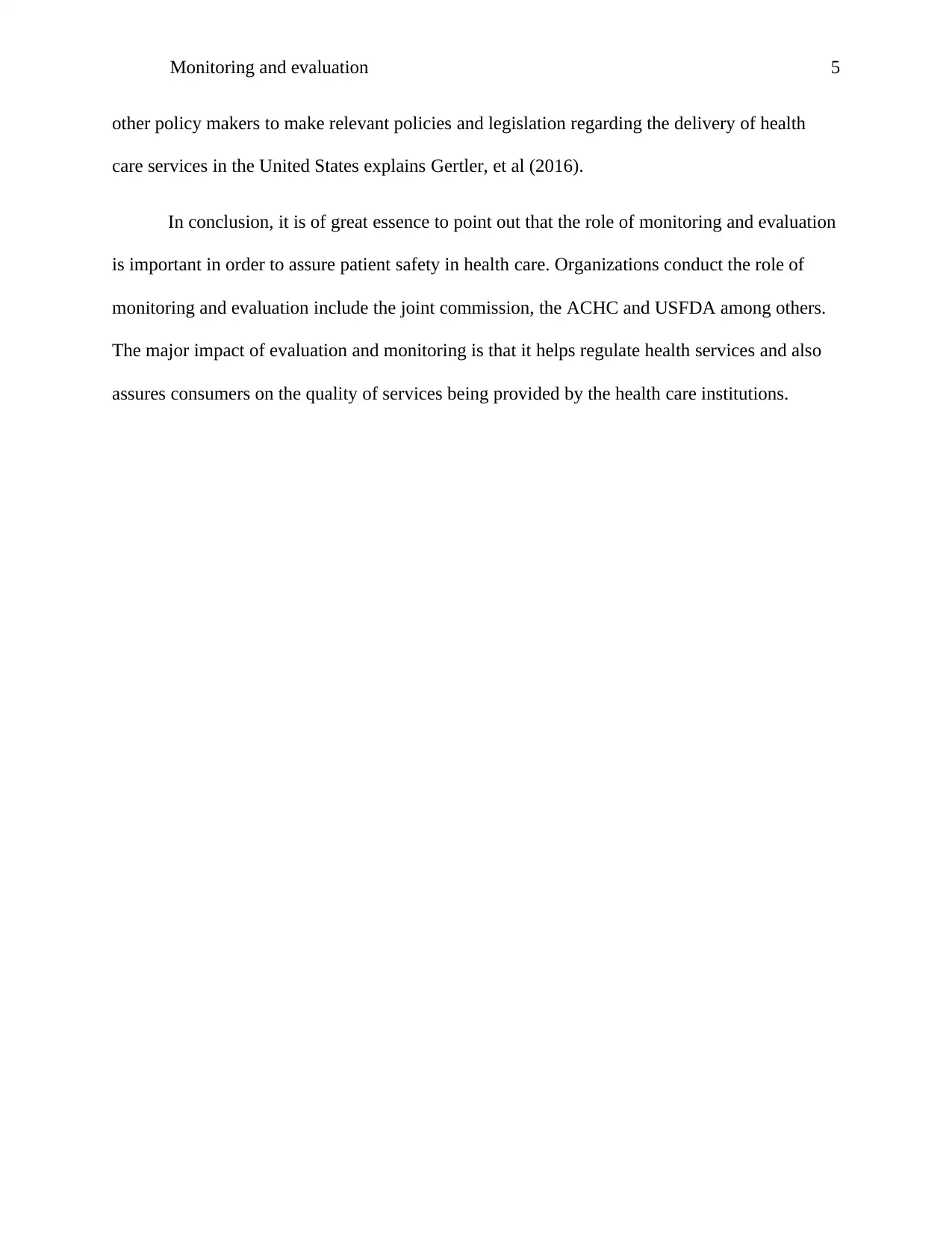
Monitoring and evaluation 5
other policy makers to make relevant policies and legislation regarding the delivery of health
care services in the United States explains Gertler, et al (2016).
In conclusion, it is of great essence to point out that the role of monitoring and evaluation
is important in order to assure patient safety in health care. Organizations conduct the role of
monitoring and evaluation include the joint commission, the ACHC and USFDA among others.
The major impact of evaluation and monitoring is that it helps regulate health services and also
assures consumers on the quality of services being provided by the health care institutions.
other policy makers to make relevant policies and legislation regarding the delivery of health
care services in the United States explains Gertler, et al (2016).
In conclusion, it is of great essence to point out that the role of monitoring and evaluation
is important in order to assure patient safety in health care. Organizations conduct the role of
monitoring and evaluation include the joint commission, the ACHC and USFDA among others.
The major impact of evaluation and monitoring is that it helps regulate health services and also
assures consumers on the quality of services being provided by the health care institutions.
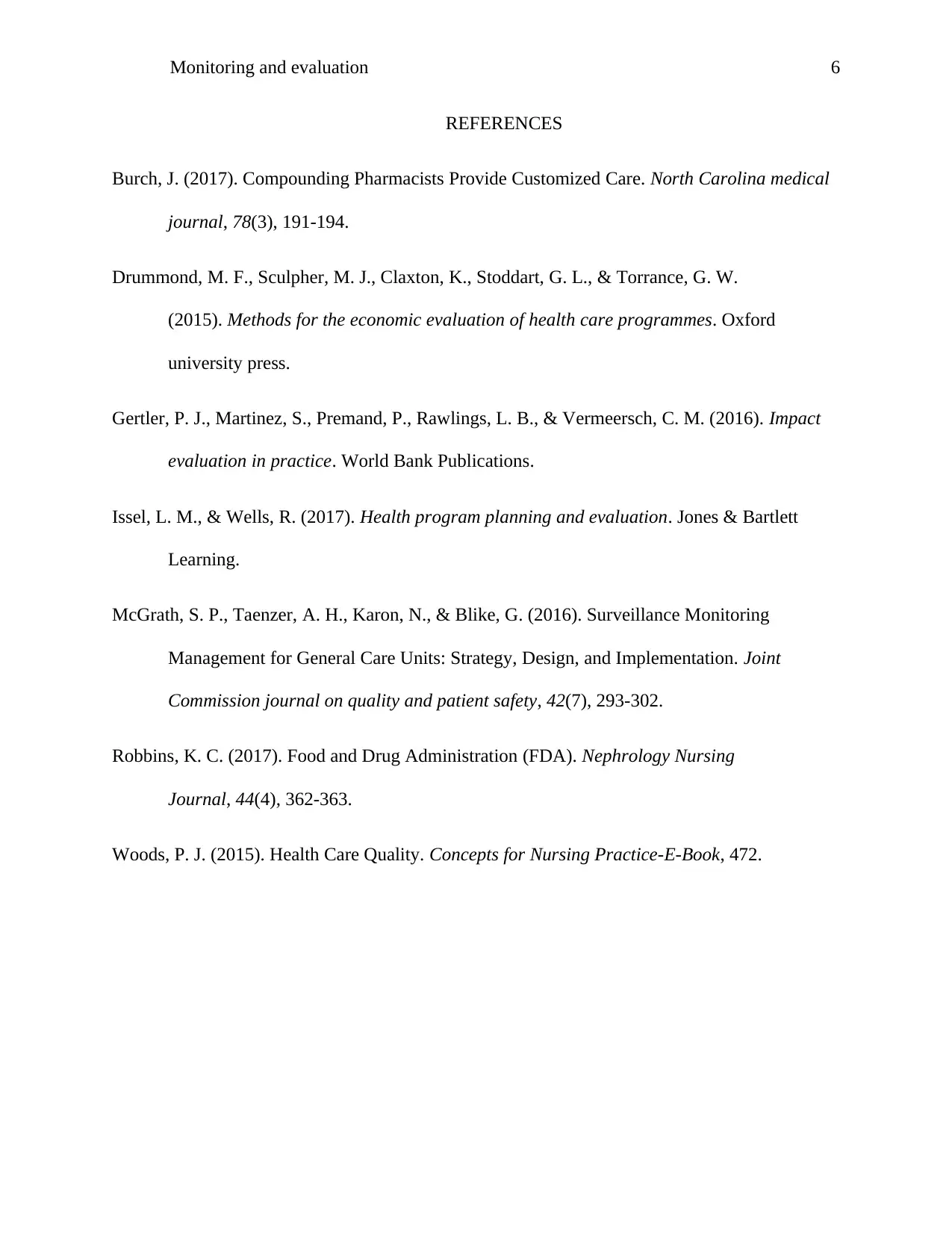
Monitoring and evaluation 6
REFERENCES
Burch, J. (2017). Compounding Pharmacists Provide Customized Care. North Carolina medical
journal, 78(3), 191-194.
Drummond, M. F., Sculpher, M. J., Claxton, K., Stoddart, G. L., & Torrance, G. W.
(2015). Methods for the economic evaluation of health care programmes. Oxford
university press.
Gertler, P. J., Martinez, S., Premand, P., Rawlings, L. B., & Vermeersch, C. M. (2016). Impact
evaluation in practice. World Bank Publications.
Issel, L. M., & Wells, R. (2017). Health program planning and evaluation. Jones & Bartlett
Learning.
McGrath, S. P., Taenzer, A. H., Karon, N., & Blike, G. (2016). Surveillance Monitoring
Management for General Care Units: Strategy, Design, and Implementation. Joint
Commission journal on quality and patient safety, 42(7), 293-302.
Robbins, K. C. (2017). Food and Drug Administration (FDA). Nephrology Nursing
Journal, 44(4), 362-363.
Woods, P. J. (2015). Health Care Quality. Concepts for Nursing Practice-E-Book, 472.
REFERENCES
Burch, J. (2017). Compounding Pharmacists Provide Customized Care. North Carolina medical
journal, 78(3), 191-194.
Drummond, M. F., Sculpher, M. J., Claxton, K., Stoddart, G. L., & Torrance, G. W.
(2015). Methods for the economic evaluation of health care programmes. Oxford
university press.
Gertler, P. J., Martinez, S., Premand, P., Rawlings, L. B., & Vermeersch, C. M. (2016). Impact
evaluation in practice. World Bank Publications.
Issel, L. M., & Wells, R. (2017). Health program planning and evaluation. Jones & Bartlett
Learning.
McGrath, S. P., Taenzer, A. H., Karon, N., & Blike, G. (2016). Surveillance Monitoring
Management for General Care Units: Strategy, Design, and Implementation. Joint
Commission journal on quality and patient safety, 42(7), 293-302.
Robbins, K. C. (2017). Food and Drug Administration (FDA). Nephrology Nursing
Journal, 44(4), 362-363.
Woods, P. J. (2015). Health Care Quality. Concepts for Nursing Practice-E-Book, 472.
⊘ This is a preview!⊘
Do you want full access?
Subscribe today to unlock all pages.

Trusted by 1+ million students worldwide
1 out of 6
Related Documents
Your All-in-One AI-Powered Toolkit for Academic Success.
+13062052269
info@desklib.com
Available 24*7 on WhatsApp / Email
![[object Object]](/_next/static/media/star-bottom.7253800d.svg)
Unlock your academic potential
Copyright © 2020–2025 A2Z Services. All Rights Reserved. Developed and managed by ZUCOL.





